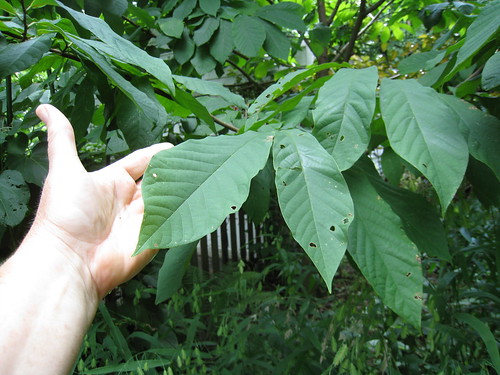 |
| Zebra Swallowtail nectars on Dogbane, photo by Joby Joseph |
The only place I seen Zebra Swallowtails in numbers is at Shaw Nature Reserve in Gray Summit, Missouri, where they were doing exactly what Glassberg describes in Butterflies through Binoculars. The group flew close to the ground, and they made quite an impression with better than 3-inch wingspan and “tails” up to an inch long. In my own yard however, I usually see a single Zebra flying near the top of my pawpaw tree.
 |
| Pawpaw leaves are large and tropical looking AMcC |
I got my pawpaw at the spring native plant at Shaw Nature Reserve. It took some teamwork to get it in the car. My friend Pat and her sister helped pack the tree, all the trays of plants, and me into the back seat. We rode back home with the tip of the tree peeking out the window of the car. My motivation for planting it a shady corner of the yard was Native Landscaping for Wildlife and People. Author Dave Tylka writes that pawpaw is the “only Midwest larval food for zebra swallowtail.” Like Pipevine Swallowtail and Monarch caterpillars, Zebra Swallowtail larvae chow down on a plant that other plant predators can’t abide. In an article on Beetles in the Bush, Ted MacRae mentions the alkaloids that protect the plant’s bark and seed from insects.
Besides Zebra Swallowtail caterpillars, I would dearly love to see some fruit on the tree. At the camp where I worked many summers, a grove of pawpaws grew at the base of the hill we called Sunnytop. Remembering the song—“pickin’ up pawpaws, put ’em in your pocket”—I looked for the fruit every summer. No luck. Knowing that he had grown up in rural Jefferson/Ste. Genevieve Counties near camp, I asked the property manager, Jim LaPlant, about the fruit. Jim laughed and told me that as a boy, others had called him “a Pawpaw-eatin’ Frenchman.” Exactly what that meant I don’t know. Reportedly pawpaws are messy to eat. Is that what these mean kids were talking about? Or was it because supposedly only unpopular people would eat them? Or was it just another in the long and regrettable tradition of insulting a person by referring to his ethnic food? Well, lots of folks do like pawpaws. By golly, Pawpaws have their own Flickr group. What’s more, on September 17-19 this year, Lake Snowden, Ohio, holds its 12th Annual Pawpaw Festival. They have an atalatal-throwing contest there too and you just don’t see that every day!
 |
| Photo by Beautiful Rust |
To grow fruit, a tree needs a pollinator. In the case of the pawpaw, it’s not butterflies, though it is a type of fly. Being an understory tree, pawpaw blooms early, before the canopy of trees block most of the light. It’s strange maroon/brown blossoms hang off the bare limbs. The scent has been described a rotting meat or, as Don Kurz describes it in Trees of Missouri, like fermenting grapes. I’ve never noticed any scent myself, but if I did, I don’t think I’d be confused between rotting meat and rotting fruit.
Kurz also explains a bit about the scientific name, Asimina triloba. “Triloba” refers to the 3-lobed shape of the flower. “Asimina” is a Latinized version of the French rendition of an American Indian name for the tree. I didn’t find any explanation of what that American Indian word was or what it mean. I didn’t find any satisfactory explanation of the word “pawpaw” either, except that it is also applied to papaya, a unrelated fruit tree.
 |
| Pawpaw Sphinx moth, photo by Seabrooke Leckle |
Whether or not my tree ever bears fruit, it will one day host larvae of either the Zebra Swallowtail or the Pawpaw sphinx moth, Dolba hyloeous. Seabrooke Leckle writes about this gorgeous moth and other large moths in a 2009 post in her blog, the Marvelous in Nature.
Special thanks to my Flickr friends (credited in the caption under the photos) who were kind enough to license their photos through Creative Commons.
"I wonder how far a 1/8th of an inch-long fungus gnat can fly?"
ReplyDeleteI guess you'll be finding out...Good luck!
I wonder if the birds simply get to these fruits too quickly. I've seen many a tree with unripe fruits hanging on them, but I have yet to find ripe fruits ready for tasting.
ReplyDeleteI've assumed, perhaps incorrectly, that "pawpaw" is a corruption of "papaya" and was so-named because of the general resemblance of the two fruits.
Yes, I think the squirrels, possums, and birds are much more determined than I.
ReplyDelete